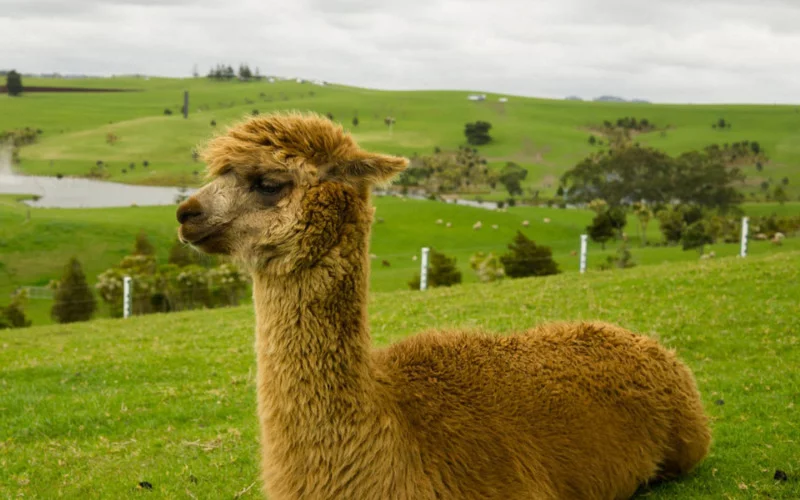Alpacas are social and friendly animals, they have soft hair and possess all the qualities of a good pet, but can I have an alpaca in my backyard as a pet?
Yes, you can! Alpacas are safe to keep as a pet, and you don’t need a large space to accommodate them; they need a fenced area. If you have a barn, then it is also good for them.
We have explained all you need to know about alpacas and having them as pets. We have covered the amount of space needed for this animal, some fun facts, and its differences from a llama.
Can I have Alpacas As Pets in My Backyard?
Alpacas are known for their provision of fleece for spinning yarn; obtaining their fleece usually happens once a year, and it has been a great source of income for most livestock owners.
Alpacas are mostly found in South America around mountains in Peru. Some of the common breeds of alpacas include Huacaya alpacas and Suri alpacas.
It has become more common for alpacas to be kept as pets in North America, and it costs up to about $500 to purchase an alpaca.
If you keep an alpaca as a pet, it is not expected to reproduce as its sole purpose is to offer companionship to its owners. Usually, a relationship between humans and pets opens up one’s perspective to living as an emotion is also formed.
How Much Land Do Backyard Alpacas Need?

The space you need depends on the number of alpacas you intend to keep a pet. If you have five alpacas, you can keep them all in a field as big as one acre; 10 alpacas can also fit in this space, but because you need some space for their food keeping, ten alpacas in a one-acre land can get crowded.
Alpacas are usually fed on hay, alfalfas, and fescue grass. If you have a field, you can keep the alpacas there where they have access to fresh and clean grass.
You will need to clean their housing regularly to prevent the spread of any disease. For the safety of this animal, make a fence around their home; we highly recommend a chain-link or mesh fence.
This fence protects alpacas against predators like mountain lions, coyotes, and bears, although an appearance of a predator depends on where you live.
Medical Care For Alpacas
Alpacas are easily prone to diseases when exposed to a dirty environment and unclean food. Regular medical cares for alpacas include checkups, deworming at the appropriate time, administering vaccines occasionally, and clipping their nails.
Vaccines administrations may be restricted for pregnant alpacas. This is because the substances in the vaccines may harm the cria or the mother. Check vaccines properly before giving them to alpacas.
Differences Between Llamas And Alpacas
Alpacas and llamas are similar in a lot of ways, and because of their physical similarity, a lot of people get confused and are unable to tell them apart.
These animals are related to camels from the eastern hemisphere and have thick hair and a slightly longer neck, but unlike a camel, neither an alpaca nor a llama has a hump.
Alpacas have shorter ears similar to a spear shape, while that of a llama resembles a banana. Llamas are heavier than alpacas as they can weigh up to 400 pounds while the latter weighs about 150 pounds; the shoulder of a llama sits between 40 to 46 inches, while that of an alpaca is between 32 to 36 inches.
Llamas have a longer face and are usually bred for their meat, while alpacas have shorter faces for fiber (fleece). Alpacas have thicker and soft hairs on their body and face than llamas, and they are more of a herd or domestic animal, while llamas are somewhat wild.
Fun Facts About Alpacas
There are some grabbing details about alpacas that make them fascinating. These facts make up an alpaca and its behaviors.
- Alpacas are old: alpacas are known to have lived up to 5000 years and were valuable because of their fleece and high quality; it was known as prestigious and were sold for a very high price.
- Their population increases: even though they are ancient, one would expect their population to decrease, but that’s not the case. About half a century ago, there were only a few alpacas, and they were caged in zoos located in the United States until importers transported some herds to other parts of America and Canada. Since then, the population of alpacas has grown to about 250,000, and you will find that this animal is more in Ohio.
- They are considered therapeutic animals: it’s not often that you find a companion in most animals, but alpacas are very friendly and social that they can keep you company. They are used in hospitals, retirement homes, and other healthcare centers as therapy animals.
- They can crossbreed with llamas: alpacas are closely related to llamas and are often confused together because of their striking physical similarities. The Huacaya breed of a llama is known for its thick hair, while the Suri llama is known for its quality wool. The crossbreed between a male llama and a female alpaca is known as llalpaca, and they are found in South America.
Conclusion
If you have seen an alpaca and like its thick hair and friendly vibe, you can keep it as a pet in your backyard. You do not need a lot to care for an alpaca, and if you want more than one, you are free to get as much as you want, providing that you have enough space and food for them. Five alpacas can live on an acre of land, and they feed mostly on hay and alfalfas.
You will also need to provide them with medical care and security through proper fencing. We have covered some of the basic differences between a llama and an alpaca above to help you tell the difference, and we have also shared some fun facts about this animal.
Helpful Articles:
- Best Tetherball Set for Dogs
- What is Pigeon’s Favorite Food?
- What Do Backyard Bunnies Eat?
- What To Do With Backyard Dog Poop
We trust this article helped you know if you can have an alpaca in your backyard as a pet. You may also want to check out the Best Way to Catch a Wild Bird in Your Backyard?
Thanks for taking the time to read our article, and we hope you find it helpful. Would you mind leaving a comment below if you have any suggestions?
Kindly reach out to people by sharing this post on social media.
If you liked this article, then please follow us on Facebook, Instagram, and Pinterest.


